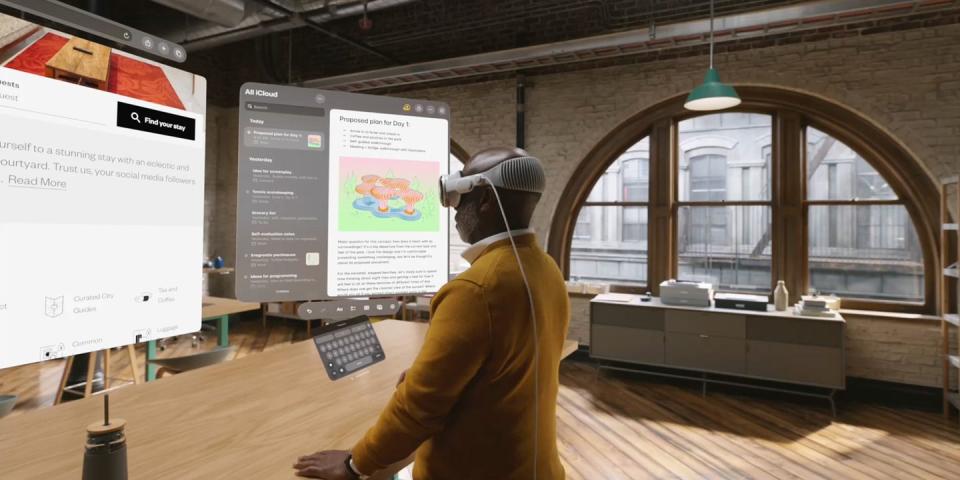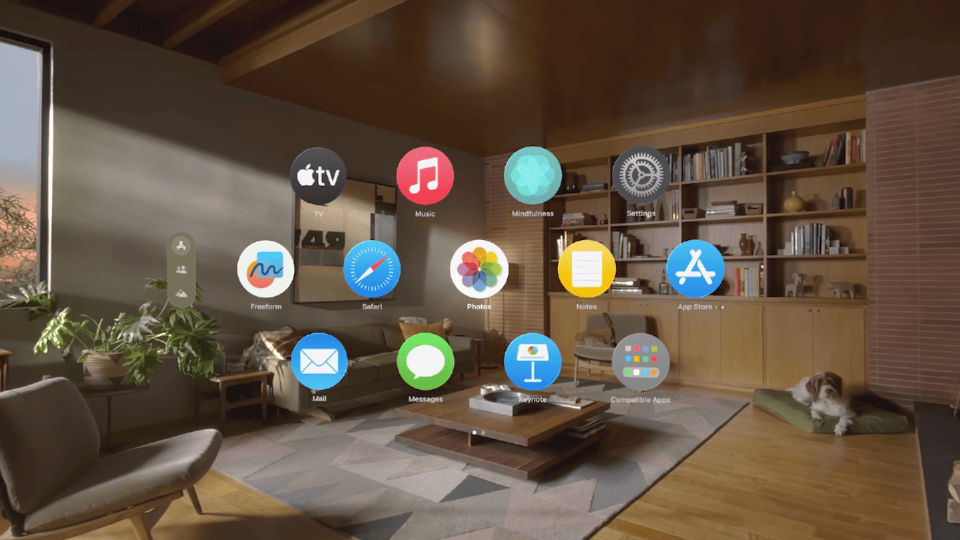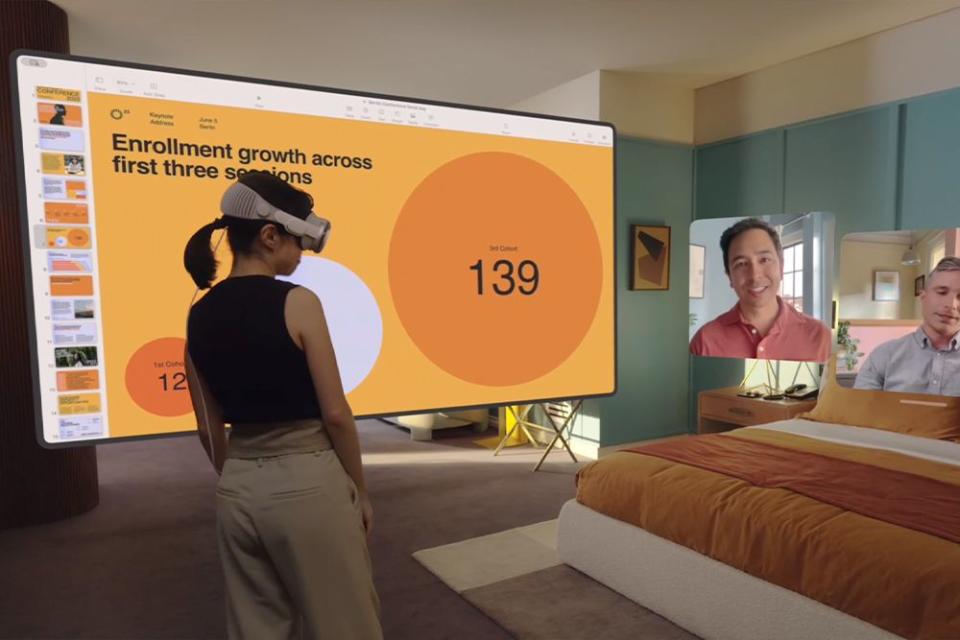Apple Vision Pro AR Headset: 5 Reasons We’re Excited

Apple just had its next iPhone moment with the unveiling of its Vision Pro mixed reality headset, which doesn’t launch until early 2024. This augmented reality goggles use the latest in display and computing technology to overlay realistic 3D objects and sharp text atop your physical space. An immersion control dial lets you activate a virtual reality mode that fully replaces your surroundings.
This creates a customizable workspace or private theater anywhere you go, whether at the office or riding in a train. If any company can bring spatial computing mainstream, it’s going to be this tech giant in particular. Here’s why.
Apple’s Sleek, Powerful Hardware Design Is in Its DNA
While Apple isn’t known for being the first to a product category, it usually ends up overtaking it with stronger hardware. The Apple Vision Pro is much more compact and lightweight compared to current mixed reality headsets like the Meta Quest Pro and Microsoft HoloLens. It’s also a spec beast that provides a much sharper picture and generational leap in graphics. Vision Pro is finally viable thanks to recent advancements in Micro OLED display technology and sharp 4K resolution.

It packs 64 pixels into each microscopic space then aligns them in rows to provide over 23 million pixels within lenses the size of postage stamps. This achieves true 4K video with vivid high dynamic range colors while text looks crisp from any angle. That’s important for those who would wear the headset extensively when editing video or working on text-heavy documents for hours on end. There’s a mix of 12 cameras, 5 sensors, and 6 microphones on the device, and the whole thing is powered by two Apple silicon chips—the powerful M2 processor and the other a brand new R1 chip for mixed reality. This secondary sensor processes realistic effects like adjusting icon transparency based on light in a space or dropping shadows from open windows atop the real world to understand scale and distance.
Unlike standard AR smart glasses the Vision Pro supports mixed reality so you can switch to a virtual reality environment to tune out real world distractions. Twist the side crown and you can surround yourself in dynamic photorealistic backgrounds. That means you can work across a multi monitor setup on a beach or watch a theater-sized screen even if you’re actually in the middle seat of a fully packed airplane. However the Vision Pro’s cameras were the unsung heroes of the keynote event, as they can snap spatial photos and videos with added layers of depth. Now you can “step into” the environments captured in these moments to experience memories in a new way.
Apple nailed the aesthetics with this first generation headset. Its breathable and lightweight back strap design prioritizes comfort, which is important for getting people on board for everyday use. Its soft knitted stretch construction is modular and can be swapped out like the bands of an Apple Watch. And its speakers rest over your ears to provide rich spatial audio while still allowing you to hear your surroundings. I have just a single reservation about its external battery pack, which is about as bulky as the size of a standard power bank. It offers just two hours of battery life (it works all day if plugged into a consistent power source)—which is just okay when you consider this will cost $3,499. Otherwise this design will undoubtedly inspire headsets for years to come.
VisionOS Interface Is a New Platform With Familiar Roots
Another promise are its smooth and glitch free user interfaces. Macs and iPhones are popular because they just work. Almost anyone can grasp how to easily hop between windows and focus on their tasks. VisionOS looks to be as seamless as MacOS and iOS. After throwing on the headset you are greeted by the “Home View,” which is where apps and widgets live. In fewer than a handful of taps, you can get what you need up and running. This fully 3D operating system is built from the ground up for AR but icons and apps look familiar to those on Mac and iPhone. In fact, the Vision Pro headset seamlessly integrates with the broader Apple ecosystem. Messages, photos, and documents synced to iCloud are all accessible on the headset so you can pick up where you left off on other devices. Plus you have access to Siri and the App Store to download a wide range of AR tools and experiences.

VisionOS combines the Mac and iPhone’s best features into a standalone set of goggles. The difference is that you navigate it primarily using your eyes, hands, and voice instead of touch or a mouse. High speed infrared cameras and LEDs monitor your eyes so you can use your gaze as a cursor. With a response time of just 12 milliseconds, this is much snappier than what you could achieve by hand. Just a pinch and swipe of your fingers makes a selection or moves tabs around for a natural level of control. However, the headset will work with traditional wireless accessories like a keyboard. You need a familiar foundation to transition into a new generation of computing.

Until this point, headsets like the popular Meta Quest 2 have struggled with operating systems. While it’s a fantastic VR headset, it’s marred by a confusing and unintuitive layout that feels like it’s fighting itself. Apple’s expertise in computing makes navigation and multitasking more accessible. One clear example is the tech giant demonstrated its handoff feature with a MacBook. During the keynote, a worker took out a 14-inch MacBook while wearing the headset. The Vision Pro instantly recognized the display and wirelessly beamed it up to a floating virtual screen. This took it from a 14-inch physical screen to a customizable, private window that could be stretched out to fill the room.
Another exciting new feature is EyeSight. This taps into the inner camera hardware to relay your eyes and immersion level to the real world on the front panel’s OLED display. While your headset would appear cloudy from a distance, this changes as someone approaches you. The headset slowly pops them into your virtual environment based on their proximity while the front of the headset gradually reveals your eyes for a transparency effect. While today’s VR headsets will show you when someone crosses your path, you almost always have to remove them to have a proper conversation. EyeSight makes it so you can leave your headset on and still be present to those around you.
New Gaming and Entertainment Experiences
If you’ve played “Pokemon Go” you know just how exciting it is to see a 3D creature rendered in your space on your phone’s screen. With the Vision Pro you look through a screen, not at one, to see digital content for more immersive gameplay. This means you can lose yourself in games and explore digital worlds that seamlessly blend with your physical environment. Even if you choose not to render full digital surroundings you can simply use the Vision Pro to create a movie theater–sized screen anywhere to play Apple Arcade games or watch TV.
During the keynote, Disney showed off how its VR mode could be used. After throwing on a headset the presenter opened up “The Mandolorian” on the Disney Plus app. After activating the VR mode, they were able to beam a floating theater screen several feet in front of them while watching from a ship in the Star Wars universe. If they gazed up or to the sides, they were surrounded by lore and 3D renders of planets on a galaxy map just outside their field of view, so they could go even deeper into the franchise.

After this showing, Apple announced its support for Unity which makes it easy for most game developers to port existing titles or work on experiences which will help bolster the headset’s offerings. A steady stream of third party content is crucial to success, as best demonstrated by the popularity of the App Store which further bolstered Apple hardware sales.
More Immersive Remote Collaboration
With more people working from home, digital communication remains in the spotlight. Virtual spaces and and digital avatars have been a struggle point for the XR industry over the past decade. Apple’s Vision Pro uses its high-end cameras to accurately scan and digitize your likeness for video calls and meetups.
This is a massive step up from Meta’s Quest mixed reality and VR headsets which use crude cartoons for its chat and work apps. Just take a look at what Apple’s hardware is capable of (left) compared to Meta (right) in the comparison shot above. The Vision Pro’s realistic high-end avatar system will pave the way for more lifelike presence over the internet.
Microsoft Teams and other work platforms were listed in the keynote as apps that will eventually make their way to the headset. In addition to more realistic avatars, Apple showed how easy it is to share 3D models and bring them into your space. This streamlines the sharing of ideas and helps better visualize prototypes without physically having objects on hand.
Competition in the AR and VR Hardware Space
Finally, the Vision Pro headset is exciting because rivalry breeds innovation. Apple entering the extended reality space means that both AR and VR technology is here to stay and is useful in real world applications. Apple’s initial foray into mixed reality is premium and quite expensive at $3,499. But with more people aware of the technology an opportunity arises for competing companies like Meta and Nreal.

For example, for the price of the Apple headset you could buy seven upcoming Meta Quest 3 mixed reality headsets. And Nreal’s Air AR Glasses are already available now for just $400. These come complete with a full AR multi-monitor workspace when paired with Android phones equipped with a modern Snapdragon processor. And when plugged into any device with USB-C video out they project its display on a 130-inch screen six feet ahead of you. As AR and VR headset sales struggle, the Vision Pro will bring attention to these products and could be a much needed shot in the arm for the space to help move more units overall.
You Might Also Like

 Yahoo Sports
Yahoo Sports 